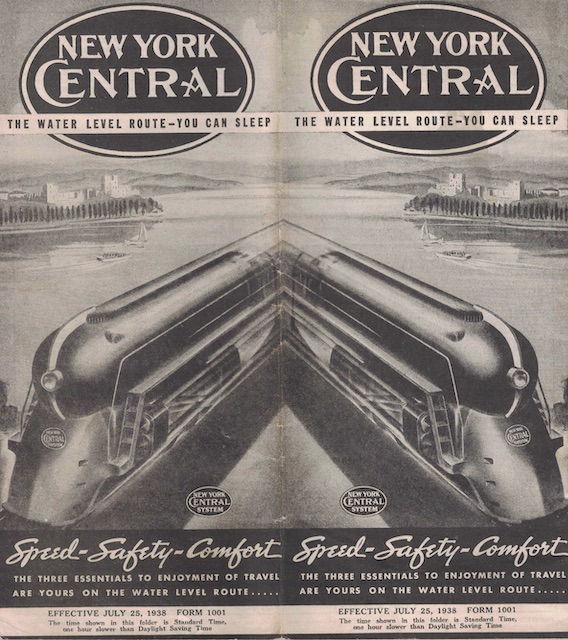This timetable, scans for which were contributed by a Streamliner Memories reader, went into effect just 40 days after New York Central inaugurated the Henry Dreyfus-designed streamlined 20th Century Limited. Wikipedia says this “was probably the most famous American passenger train” (not that Wikipedia is 100 percent reliable about such things).
 Click image to download a 26.3-MB PDF of this timetable.
Click image to download a 26.3-MB PDF of this timetable.
The bullet-nosed locomotive is pictured on the cover (actually the back cover) and also advertised, with a somewhat exaggerated illustration of the locomotive, on the other cover (technically the front cover) of this timetable. This ad states that the train went 960 miles in 960 minutes. New York to Chicago over the New York Central was actually 961 miles, but that didn’t have quite the ring to it.
I have to admit I am often confused by timetables of railroads that ran numerous heavyweight trains that often changed their consist several times during the course of a journey. I count six daily trains that made it all the way from New York to Chicago, but eight trains from Chicago to New York.
The 20th Century Limited, Commodore Vanderbilt, Lake Shore Limited, and Wolverine went in both directions. Westbound I also see train #5, the Mohawk and train #9, the Fast Mail (which was the slowest train in the corridor). Eastbound, train #6 was called the Fifth Avenue Special, train #10 was the Water Level Limited, train #14 was the World’s Fairliner, and train #90 was the Forest City Special.
The counterpart for train #90 was train #89, also called the Forest City Special, but it only went from Cleveland to Chicago. Train #9, the Fast Mail, was not the counterpart for train #10 as the latter had through sleeping and lounge cars between Chicago and New York and the former did not. Nor is it clear that train #5 was the counterpart for train #6 as the latter had a lounge car from Chicago to New York while the former had a lounge car only from Buffalo to Cleveland. There was no train #13, but train #15 couldn’t be the counterpart to train #14 as #15, the Ohio State Limited, only went as far as Cleveland on the main line and then headed down to Columbus and Cincinnati.
It sounds like a lot of passenger cars should have been piling up in New York City. However, in addition to the trains go Chicago, well over 40 trains left Grand Central each day for intermediate points such as Buffalo, Cleveland, and Detroit, and other trains left those cities for Chicago. Thus, the railroad got the cars it needed back to Chicago somehow.
One curiosity, for example, is train #43, listed on the equipment pages as the South Shore Express. This train made it all the way to Chicago, but started as a coach-only train in Poughkeepsie, just 72 miles outside of New York City. It picked up sleeping cars (some from Boston, some from New York City), parlor cars, and a diner in Albany. The diner went to Detroit, so the train picked up another diner in Cleveland. By the time it got to Chicago, most of those cars were detached for some other destination such as St. Louis so only the coaches were left. But how did they get to Poughkeepsie in the first place?

The equipment listing reminded me of a trip to Florida I took on PRR’s “South Wind” in the early 1960’s. That train also had a 13 Double Bedroom Pullman on it. These cars were pre-WWII and did not offer enclosed toilets and sinks. In fact, the toilet pulled out from a cabinet adjacent to the lower berth. Post war, wiser heads prevailed and the “facilities were enclosed in a small compartment that opened into the bedroom. The room count, however, dropped to 12 or 11 Double Bedrooms.